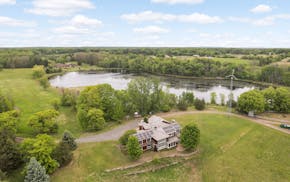MOUNTAIN LAKE, MINN. – The corn succumbing to the forks of Brandon Fast's combine this autumn morning is green. It shouldn't be. But the floods of June are finally being felt.
"Two years ago, this was 270 bushel an acre," said Fast, who has farmed since high school in this southwestern Minnesota town of 2,000. "Right now?"
Fast, 46, glances at the colorful numbers rotating on a digital screen hanging inside the cab of his John Deere. "Our average right now is right here at 169″ bushels per acre.
June dumped more than a foot of rain on Cottonwood County. Across South Dakota, Iowa and Minnesota, water spilled from fields, overflowing streams and destroying culverts. A bridge was knocked out a mile from Fast's farm. Fifty miles east, a dam above Mankato on the Blue Earth River was imperiled, briefly capturing the nation's attention.
With corn above $4 a bushel, Fast estimates he'll average a $200-an-acre loss. He farms 700 acres.
It could've been worse. Many of his fields are lined with drainage tiles — perforated pipes that drain water from fields to streams. But on this one? "Not a lot of tile in here," said Fast, shaking his head.
The tiling irrigation system, the same one that saved some of Fast's corn crop, came under scrutiny as partly to blame for the flooding itself. Even before the floodwaters washing across south central Minnesota highways and basements dried, some observers pointed to the drainage tiles in farm fields across the region for boosting the flood's destructive power. One researcher, an expert in the region's hydrology, has estimated tiling was responsible for increasing the peak flow of the Blue Earth River by 20% to 40%.
Over the decades, the piping latticing southern Minnesota's fertile blue-black clay transformed the region's fields, including wetlands and sloughs, into expansive agricultural plots. Skeptics say the practice increases sediment erosion and nitrate pollution downstream and, as seen in June, increases the intensity of water sent rushing downstream during a storm.
"We've really re-plumbed this part of the state," said Carly Griffith, water program director with the Minnesota Center for Environmental Advocacy. "In some counties, we have more miles of ditches and sub-surface tile lines than roads."
While tiling the state's croplands is nothing new, a wetter climate in southern Minnesota is creating worry that the farm's drainage infrastructure could exacerbate already destructive floods.
***
For people living in rural southern Minnesota, tiling is as common as gravel roads. Beginning in the 1800s, farmers placed clay tiles on the landscape to transform a prairie parcel into pasture. Those pastures turned to row-crop fields with even greater drainage. Concrete tiles replaced clay, and in the latter half of the 20th century came high-density polyethylene piping.
Today, drainage companies dot the outskirts of towns. They sponsor T-ball teams. They drive vehicles down main street in parades. And they're often busy, with many farmers on waiting lists months, even years out to tile a field.
On an October morning in Dodge County, a tile team from Hodgman Drainage Co. is in the field that had been covered with corn until a few days earlier: a couple pickups, an excavator, and a Dutch-built drainage trencher. The trencher scoops up the black dirt and slips a perforated black tube into the earth before burying it. It's like a gigantic zipper running over the fields. The team can move quickly, embedding pipe into a field in just a couple of days.
"You talk to any farmer or get on any ag site, the best investment is, No. 1, drain tile," said Dan Hodgman, president of Hodgman Drainage Co. "The next is probably grain bins because … you've got to store more corn."
For generations, putting in tile meant "improving the land" — a mark of progressive farming. While tiles drained wetlands, the technology also made southern Minnesota a vital part of the nation's corn belt, growing livestock feed and biofuels.
Hodgman has heard the criticisms, too. Rather than leading to overflow in the region's water systems, a tiled field, he says, acts like a "big sponge." Rather than sending rainwater immediately flowing downstream, the land absorbs the water.
But in the biggest rains, tiles won't stop the water.
"You get a 5-inch gully-washer in an hour, I don't care how much tile in the world you got," he said, "you're going to have erosion."
***
The flooding that overwhelmed large parts of the Minnesota River Valley this June was set up months before, when significant rains started falling by late March. While drought has overwhelmed farmers for a number of years, Kenneth Blumenfeld, a senior climatologist with Minnesota's State Climate Office, notes that the state is getting consistently wetter due to a warming atmosphere. And more water will need a place to drain once it hits the fields.
The tiles create a runway for water filtering through the soil to move more quickly to drainage ditches and, eventually, to the nearest river. Along with water, the tiling also increases the sediment load farther downstream.
Patrick Belmont, a professor in Utah State University's Watershed Sciences Department who led a research project mapping the riverways around Mankato in the late 2000s, watched the flood with a sense of resignation over the summer.
He's one of the few people who have extensively studied the hydrology of the tributaries of the Minnesota River around Mankato, and he authored a report to the Legislature in the 2010s that called, in part, for storing water on fields rather than relying solely on tiles.
"There were problems with the [Rapidan] Dam, no question about that," said Belmont. "But the fact [is] that flood was … higher than it would've been without the tiles."
Soil from south central Minnesota farm fields can be seen in the over-sedimentation of Lake Pepin and farther down the Mississippi River to the Gulf of Mexico. But research shows that the tillage of farm fields and runoff aren't the only culprits.
The Blue Earth River is one of the fastest downcutting, or vertically eroding, rivers in the world, and heavy tillage — from plows of the 19th and early 20th centuries — subsided by the middle of the 1900s. Belmont has found that tiling played a role in increasing sediment load by maximizing the flow of water running through streams and drainage ditches.
"The [tiles] really work. They do their job effectively," Belmont said. "Now [water] is getting through the soil and into the river that same day, within hours. We've fundamentally changed the connectivity of the river."
***
Not far from Hodgman's shop, on a field southeast of Rochester in October, just near a spur of the Whitewater River, Lt. Gov. Peggy Flanagan jumps down from a yellow combine to speak with the media. She stands near Dana Allen-Tully, an Olmsted County dairy farmer and president of the Minnesota Corn Growers Association, at an event to honor conservation practices.
Allen-Tully surveys her land, including a small clump of trees rising near the Whitewater, which runs through a state park on the way to dumping into the Mississippi River south of Kellogg, Minn. She adds a little bit of tile each year, strategically.
"Two years ago we had waves," said Allen-Tully. Where the field had dried, the corn was taller "and the root was able to develop, versus a root that's sitting in water."
With corn prices hovering above $4, nearly half of what they were a couple of years ago, she can't afford to waste any rows. Every plant-grower knows the No. 1 killer of plants is too much water. And the best way to get rid of that water, farmers agree, is tiling.
"You know," Allen-Tully said, describing corn sitting in a pool of water, "it's drowning."
Hodgman argues the critics misunderstand his industry. This past summer, he said, was a case-study for why farmers want to tile. Hodgman can drive around fields in Dodge County and tell which farmers have and haven't tiled based on the height of their corn.
"People that put tile in were probably some of the most innovative [farmers]," Hodgman said. "They knew they could produce better crops by draining the excess water."
***
When Belmont published his research, in 2011, he proposed a way to recreate wetlands by taking land out of production. The message was engulfed in politics, he said, but he stands by the solution.
"There's a lot of ways to put water storage back on the landscape," he said. "You can use 4 percent of the land, take it out of production and use for temporary water storage, and you can get a 40 percent reduction" in sedimentation.
The tug-of-war over where water flows once it hits southern Minnesota farm fields is not ending anytime soon. In August, the city of Mankato voted to demolish the remains of the Rapidan Dam. The Minnesota Pollution Control Agency compared water samples on the Blue Earth River below the dam and founded sediment, phosphorus and organic nitrogen levels "greatly exceeded" historical levels.
"As of Nov. 11," an MPCA spokesperson said in a statement to the Star Tribune, water clarity "still has not returned to expected values for the time of year."
Still, even in the aftermath of the 2024 floods, few expect drastic change in farm drainage across the state. Corn yields are the lifeblood for so many farmers, and the USDA's most recent agricultural census, conducted in 2022, showed that eight of the top ten U.S. counties where tile drainage was growing fastest were in southern Minnesota, including Cottonwood County.
Minnesota farmers finished harvesting corn in early November, weeks ahead of normal. But while states to the south expect bumper crops, the USDA predicts a smaller corn harvest for Minnesota than a year ago. Many blame the wet conditions early in the growing season.
Out west, Fast says, "we'd love to have everything pattern-tiled, but it's just not affordable. But we've got to tile within reason."
Staff writer Chloe Johnson contributed to this story.

Eco-friendly house on 30 acres near Marine on St. Croix listed at $1.6M

DOGE cuts federal money for upgrades at Velveeta plant in New Ulm

Minnesota factories strained by new steel tariffs and ensuing chaos
'We don't want to lose this mine': Fear sets in for Iron Range miners as shutdown takes hold

